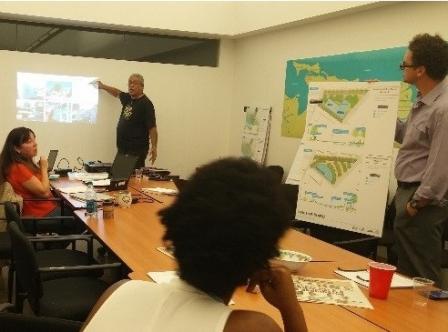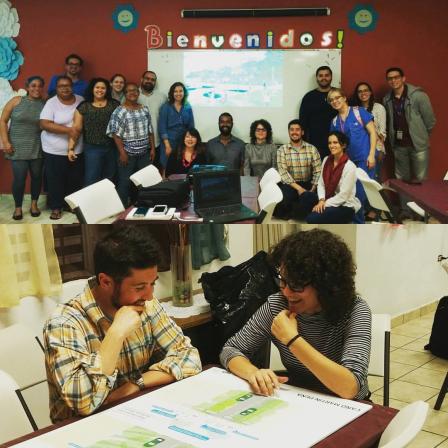Innovations in Green Infrastructure Stormwater Community Planning and Design in Puerto Rico
 Presenters and participants gather to discuss green infrastructure in Puerto Rico.Hard surfaces such as roads, parking lots, and buildings accelerate stormwater runoff to local waterways, which can quickly overwhelm rivers and streams, causing flooding and property damage in urban neighborhoods. Green infrastructure incorporates natural elements such as vegetation into a built environment to better manage rainfall and runoff on site.
Presenters and participants gather to discuss green infrastructure in Puerto Rico.Hard surfaces such as roads, parking lots, and buildings accelerate stormwater runoff to local waterways, which can quickly overwhelm rivers and streams, causing flooding and property damage in urban neighborhoods. Green infrastructure incorporates natural elements such as vegetation into a built environment to better manage rainfall and runoff on site.
EPA’s Greening America’s Communities and Smart Growth Implementation Assistance programs work in partnership with local government and community leaders to identify and develop possible green infrastructure solutions for their neighborhoods.
 Participants at the design workshop held in 2017.The waterside community of Martín Peña in San Juan, Puerto Rico, falls within a 100-year flood zone, making the 27,000 residents vulnerable to extreme storm events and sea level rise. Community organization Corporación del Proyecto ENLACE del Caño Martín Peña recently invited EPA staff to lead a design workshop on the impacts of frequent flooding on local water quality, sewer infrastructure, public health, and safety.
Participants at the design workshop held in 2017.The waterside community of Martín Peña in San Juan, Puerto Rico, falls within a 100-year flood zone, making the 27,000 residents vulnerable to extreme storm events and sea level rise. Community organization Corporación del Proyecto ENLACE del Caño Martín Peña recently invited EPA staff to lead a design workshop on the impacts of frequent flooding on local water quality, sewer infrastructure, public health, and safety.
Green infrastructure solutions like rain gardens, permeable pavement, and bioretention areas help to reduce flood risk by slowing the movement of rainwater. These techniques also filter out pollutants before they can harm human health and aquatic habitats or deter economic activities. A comprehensive “living with water” strategy can help mitigate these longstanding issues while also stimulating economic opportunities for local residents.
The design workshop, jointly hosted by EPA and ENLACE, brought together local and federal government officials, wastewater utility representatives, community leaders, design and engineering consultants, and student groups to develop local place-based urban water management solutions.
These place-based design solutions help communities implement green infrastructure techniques and strengthen local and regional capacity and opportunities for meeting their community safety, clean water, and economic goals.
This collaborative process involved multiple community-based meetings and a final report detailing customized green infrastructure design solutions for six neighborhood water plazas along the Caño Martín Peña. The recommended practices include rain gardens, retention ponds, and permeable pavement integrated with pedestrian modes of transportation to reduce runoff and flooding risk while enhancing the aesthetic appeal of the neighborhood. These place-based design solutions help communities implement green infrastructure techniques and strengthen local and regional capacity and opportunities for meeting their community safety, clean water, and economic goals.
For more information on green infrastructure solutions for local governments and communities, contact EPA landscape architect Jason Berner (berner.jason@epa.gov). Jason can also be reached by phone at 202-566-1671.
